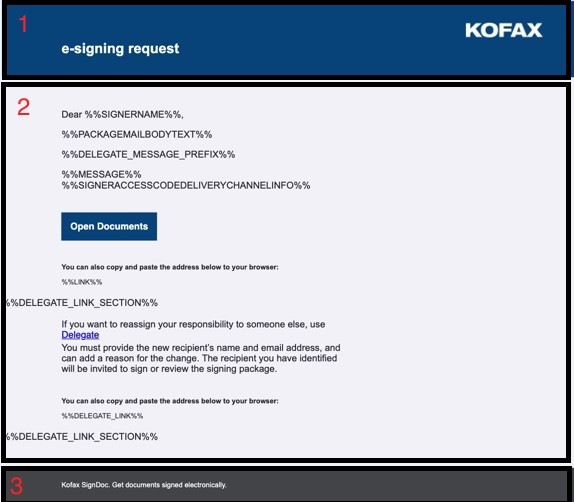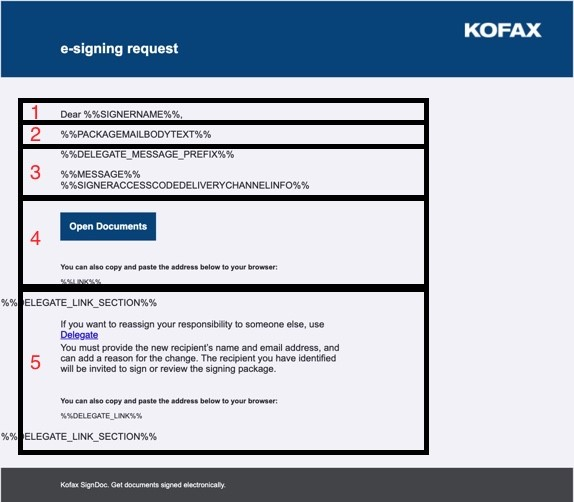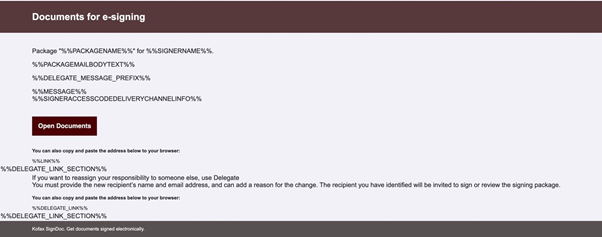Email configuration
SMTP configuration
All SMTP related settings can be configured per account selecting SMTP in the Email section.
S/MIME configuration
Outgoing emails can now be signed according to the S/MIME standard using a valid certificate and password. All certificates aligning with Java Crypto Architecture and compatible with JavaMail with a file format PKCS#12 extension are accepted.
All S/MIME related settings can be configured per account selecting S/MIME in the Email section.
Email messages
The product supports the customization of all email messages sent as part of normal operations. The subject and body of the email message can be changed to suit the needs of your organization.
Any email message can be configured:
- Globally, for all accounts.
- Individually by account.
The individual account configuration takes precedence over the global, account independent configuration. If none is given, the application reverts to the default messages.
Changes can be done on a message basis; and a mix of individual, global and default settings can be used.
Configuration entries
Email messages can be set via the configuration system or via the configuration REST API. All email configuration entries are located in the Email > General section of the configuration user interface. The settings start with the prefix mail.message. in case they are configured via the REST API.
An email message has two configuration entries:
- Subject: the email subject
- Body: the email content
Each is a configuration entry and can be changed independently.
The configuration description (also available via the REST API) describes the scope of the message.
To change an email message, the new text can be stored as the configuration content. The system starts using it after the configuration has been stored (and possibly distributed if more than one application instance is used). No system restart is required.
Placeholders
A list of placeholders that can be used in email texts is available. Placeholders are expanded to the content they represent when the email is created. For instance, %%PACKAGENAME%% is expanded to the signing package name that is referenced by the email generated.
Placeholders are only valid in context. For instance, %%PACKAGENAME%% is only valid in emails referring to signing package processing, like informing the signer of a signing package, or informing the owner of a declined package. It is not valid in an email informing the user of a changed password, since no signing package is used in that context. Invalid placeholders (out of context, misspelled) are replaced by a question mark.
For security reasons, placeholders are HTML escaped when expanded.
A list of placeholders is given below.
- Account personalization
%%LOGINLOGOURL%%: The URL of the login logo.
%%HEADERLOGOURL%%: The URL of the header logo.
%%HEADERBACKGROUND%%: The header background color.
%%HEADERFOREGROUND%%: The header foreground color.
%%FOOTERBACKGROUND%%: The footer background color.
%%FOOTERFOREGROUND%%: The footer foreground color.
%%HEADINGSTITLEFOREGROUND%%: The title foreground color for headings.
%%FOOTERLINKURL%%: The footer link URL.
%%FOOTERLINKTEXT%%: The footer link text.
-
Account
%%ACCOUNTNAME%%: The name of the account.
%%ACCOUNTID%%: The account ID (OID) used at login.
%%ACCOUNTCOMPANY%%: The company information.
%%ACCOUNTCONTACT%%: The contact information for the account.
-
Signing package
%%PACKAGEOWNERNAME%%: The name of the signing package owner (creator or last editor).
%%PACKAGENAME%%: The signing package name.
%%PACKAGEDESCRIPTION%%: The signing package description.
%%PACKAGEEXPIRATIONDATEYEAR%%: The (4-digit) year part of the signing package expiration date.
%%PACKAGEEXPIRATIONDATEMONTH%%: The (2-digit) month part of the signing package expiration date.
%%PACKAGEEXPIRATIONDATEDAY%%: The (2-digit) day part of the signing package expiration date.
%%PACKAGEMAILSUBJECT%%: The email subject that can be specified on a signing package level.
%%PACKAGEMAILBODYTEXT%%: The email content (body) that can be specified on a signing package level.
-
Signer
%%SIGNERNAME%%: The name of the signer.
%%SIGNEREMAILADDRESS%%: The email address of the signer.
%%SIGNERDECLINEREASON%%: The predefined reason the signer selected for declining the signing package.
%%SIGNERDECLINECOMMENT%%: The comment entered by the signer when declining the signing package.
%%SIGNERACCESSCODEDELIVERYCHANNELINFO%%: Information on the access code delivery channel. The method used to send the access code, such as SMS.
-
User
%%USERNAME%%: The name of the user.
%%USERLASTUPDATETIME%%: The time when the user information has last been updated.
-
Team
%%TEAMNAME%%: The team name for a team invitation.
-
Link and message
%%LINK%%: The link to be sent (context dependent).
%%LINKEXPIRY%%: The link expiry, if applicable.
%%MESSAGE%%: The custom message to be sent. Sometimes used for custom information, like the person inviting a new user in an invitation email.
%%DELEGATE_MESSAGE_PREFIX%%: Message from the original signer to the recipient when delegating the signing session.
%%DELEGATE_LINK_SECTION%%: Place holder to mark the start and end of the delegate link section.
%%DELEGATE_LINK%%: The delegate signing session link, that can be used by the recipient directly to delegate the signing session to a new signer.
Additional configuration
Some placeholders are used to expand system settings, or preset choices to text (like decline reasons). If the language of the email messages is changed for an account, there must also be a way to change the language of those pre-defined placeholders.
This can be done the same way the email messages themselves are configured. The following entries are available for this purpose:
- Decline reasons (mail.message.reason.*)
- Access code delivery (mail.message.accesscode.*)
If the language of the email messages is changed, all the entries for the categories above should also be translated to the language of your choice. The same scope as the email language change (global, or for a specific account) should be used. There is no reason to change the entries if the email language is English.
Using HTML emails
HTML can be used in the email body. The text defined as an email body is placed inside the <body> … </body> HTML tags (those should not be included in the configuration item). See the examples below for an HTML encoding.
Examples
Change the team invitation subject
Users added to SignDoc teams receive an email defined by the settings mail.message.user.add.to.team.invited.subject and mail.message.user.add.to.team.invited.body. They show in the configuration editor as Team invitation email subject and Team invitation email body.
A server administrator, by opening the Administration Center, can either change the setting for all accounts, or select a specific account first and only change the settings for that account. Any account change takes precedence over the global change.
An account administrator can only change the settings for his own account. When login in to the SignDoc Manage Client and find the configuration editor in the administration section.
The following steps are the same for both methods.
- Open the configuration editor and locate the subject entry in the
Email section.
The entry shows the current value, or a placeholder with the default values if they have not been changed yet. Also, a default value is provided above. You can use those as a starting point to design your new content.
- To add the team name to the subject change the subject to:
You have been added to the
SignDoc
team %%TEAMNAME%%.
You will notice that the ‘%%TEAMNAME%%’ placeholder is used in the text. When the email is generated, the placeholder is replaced with the actual team name of the invitation.
- Save the changes by clicking Save in the configuration editor.
- Test the new settings by adding a user to a team and looking at the email received. Use a user that has an email address you can receive.
Change the signer notification email using HTML content
In this example, the email message sent to invite signers to sign a package is customized. The settings can be found under Signer notification email subject and Signer notification email body in the configuration editor, or under mail.message.signing.subject and mail.message.signing.body in the REST API.
Note that there are different email configurations to notify a signer and a reviewer.
The signer/reviewer notification email body acts as a frame for the package notification text.
Basic Kofax e-signing notification looks like below. It has three main sections:
- Header
- Main body
- Footer

The main body also has the following logical structure:
- Request heading
- Notification body text preset by package owner while creating a package
- Additional information for email configuration (here the access code information would be displayed if the signer needs to enter an access code; also, here the delegation message would be displayed if the signing ceremony is delegated)
- Link for signing. The link is used twice, first formatted as a button and then as text, in case the user prefers to view it as such.
- Delegation section. Displayed only if the delegation option is allowed by package owner. In this case %%DELEGATE_LINK_SECTION%% marker is removed by server. In case the delegation is not allowed all the section is removed from message.

To create a custom email notification following the basic e-signing notification logic, first create an HTML table with three rows: header, content and footer.
The customized colors defined in the account settings for header and footer can be used or an own design can be followed. In the example custom colors are set.
<table style="font-family:arial;background-color:#F4F4F8;color:#32323c;width:100%;">
<tbody>
<tr style="background-color:#6b4a4a;color:#fff;width:100%;font-size:24px;font-weight:bold"></tr>
<tr style="background-color:#F4F4F8;color:#32323c;width:100%;"></tr>
<tr style="background-color:#696464;color:#fff;width:100%;font-size:12px;"></tr>
</tbody>
</table>The content of the email follows the described logic and includes the heading, signing package owner-provided text and the link to the signing session. The delegation section is added for proper use of delegation option. Note that for a correct layout three rows have to be added for this section.
To customize the layout and the content the header is set as "Documents for e-signing" and the request heading is changed to contain the package name.
<table style="font-family:arial;background-color:#F4F4F8;color:#32323c;width:100%;">
<tbody>
<tr style="background-color:#6b4a4a;color:#fff;width:100%;font-size:24px;font-weight:bold">
<td style="padding-left:80px;height:80px">Documents for e-signing</td></tr>
<tr style="background-color:#F4F4F8;color:#32323c;width:100%;">
<td style="padding-left:80px">
<br/>
<p>Package "%%PACKAGENAME%%" for %%SIGNERNAME%%.</p>
<p>%%PACKAGEMAILBODYTEXT%%</p>
<p>%%DELEGATE_MESSAGE_PREFIX%%</p>
<p>%%MESSAGE%%
<br/>%%SIGNERACCESSCODEDELIVERYCHANNELINFO%%</p>
<br/>
<p style="-webkit-border-radius:2px;-moz-border-radius:2px;border-radius:2px;color:#ffffff;"><a href="%%LINK%%" style="color: #ffffff;background-color:#600101; padding:15px; font-size:16px; font-weight: bold; font-family: Helvetica, Arial, sans-serif; text-decoration: none;">Open Documents</a></p>
<br/>
<p style="font-size:12px"><b>You can also copy and paste the address below to your browser:</b></p>
<p style="font-size:12px">%%LINK%%</p>
</td>
</tr>
<tr><td>%%DELEGATE_LINK_SECTION%%</td><td height="20px"></td></tr>
<tr style="background-color:#F4F4F8;color:#32323c;width:100%;">
<td style="padding-left:80px">
<p>If you want to reassign your responsibility to someone else, use <a href="%%DELEGATE_LINK%%" style="font-size:16px;font-family:Helvetica,Arial,sans-serif;">Delegate</a>
<br/>You must provide the new recipient’s name and email address, and can add a reason for the change. The recipient you have identified will be invited to sign or review the signing package.</p>
<p style="font-size:12px"><b>You can also copy and paste the address below to your browser:</b></p>
<p style="font-size:12px">%%DELEGATE_LINK%%<br/></p>
</td>
</tr>
<tr><td>%%DELEGATE_LINK_SECTION%%</td><td height="20px"></td></tr>
<tr style="background-color:#696464;color:#fff;width:100%;font-size:12px;">
<td style="padding-left:80px;height:40px">Kofax SignDoc. Get documents signed electronically.
</td></tr>
</tbody>
</table> Note the use of the placeholders:
- %%HEADERBACKGROUND%%, %%HEADERFOREGROUND%%, %%FOOTERBACKGROUND%%, %%FOOTERFOREGROUND%% expands to the colors defined in the account customization.
- %%SIGNERNAME%% expands to the signer name.
- %%PACKAGEMAILBODYTEXT%% expands to the package email body defined by the signing package owner.
- %%SIGNERACCESSCODEDELIVERYCHANNELINFO%% expands to the delivery channel description used to send the access code, if given.
- %%LINK%% expands to the link leading to the signing session for this package.
By removing spaces, line breaks and other formatting elements, space can be saved and delays minimized. If the HTML has been edited in an external editor, the result can be pasted into the "Signer notification email body" setting in the configuration editor:
<table style="font-family:arial;background-color:#F4F4F8;color:#32323c;width:100%;"><tbody><tr style="background-color:#6b4a4a;color:#fff;width:100%;font-size:24px;font-weight:bold"><td style="padding-left:80px;height:80px">Documents for e-signing</td></tr><tr style="background-color:#F4F4F8;color:#32323c;width:100%;"><td style="padding-left:80px"><br/><p>Package "%%PACKAGENAME%%" for %%SIGNERNAME%%.</p><p>%%PACKAGEMAILBODYTEXT%%</p><p>%%DELEGATE_MESSAGE_PREFIX%%</p><p>%%MESSAGE%% <br/>%%SIGNERACCESSCODEDELIVERYCHANNELINFO%%</p><br/><p style="-webkit-border-radius:2px;-moz-border-radius:2px;border-radius:2px;color:#ffffff;"><a href="%%LINK%%" style="color: #ffffff;background-color:#600101; padding:15px; font-size:16px; font-weight: bold; font-family: Helvetica, Arial, sans-serif; text-decoration: none;">Open Documents</a></p><br/><p style="font-size:12px"><b>You can also copy and paste the address below to your browser:</b></p><p style="font-size:12px">%%LINK%%</p></td></tr><tr><td>%%DELEGATE_LINK_SECTION%%</td><td height="20px"></td></tr><tr style="background-color:#F4F4F8;color:#32323c;width:100%;"><td style="padding-left:80px"><p>If you want to reassign your responsibility to someone else, use <a href="%%DELEGATE_LINK%%" style="font-size:16px;font-family:Helvetica,Arial,sans-serif;">Delegate</a><br/>You must provide the new recipient’s name and email address, and can add a reason for the change. The recipient you have identified will be invited to sign or review the signing package.</p><p style="font-size:12px"><b>You can also copy and paste the address below to your browser:</b></p><p style="font-size:12px">%%DELEGATE_LINK%%<br/></p></td></tr><tr><td>%%DELEGATE_LINK_SECTION%%</td><td height="20px"></td></tr><tr style="background-color:#696464;color:#fff;width:100%;font-size:12px;"><td style="padding-left:80px;height:40px">Kofax SignDoc. Get documents signed electronically. </td></tr></tbody></table>The new layout in a new browser tab can be tested by clicking the Preview button on the right of the inline editor. In the preview placeholders are not expanded.

After saving the changed setting the new layout can be tested with expanded placeholders by creating a signing package with a signer with your email address, and viewing the email received.
The email after all server replacements will look as following.
